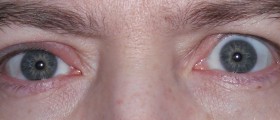
A stye is a small boil on or just under the eyelid that can result from an inflammation of an eyelash follicle or an infected gland in the eyelid. This usually painful eye condition seems to affect children more than adults. In the majority of cases it is caused by a staphylococcus infection of the eyelid.
Styes look like small boils on the eyelid, on the external or the internal side of it. while external styes are easily noticeable from the outside, internal styes, which are located on the inside of the eyelid, can be detected by pulling the eyelid slightly down.
Symptoms of a stye
Styes usually start with an itching sensation in the eyelid and they often feel like there is a grain or sand or a speck of dirt under the eyelid. The pain is throbbing and can be very intense. When the stye becomes visible, it takes form of a boil, which is usually red and swollen, sometimes filled with pus. The entire eye may become red and slightly swollen, especially the affected eyelid. In the final stages, the boil may burst, releasing the pus. It may become difficult to open the eyes, especially in the morning, because the pus that dries up causes the eyelids to stick together, as if glued.
Causes of styes
One of the major causes of styes is an infection of one or more follicles that contain the root of the eyelashes. The infection is often bacterial. A stye can also develop due to blockage of small glands located in the eyelid, due to dirt. Infections can easily spread from one hair shaft to another, especially if the eye is scratched.
Recurrent styes are mainly caused by weakened immune system, where the response of the body to harmful agents, infections and irritations is not adequate. This is particularly seen in people who are recovering after illnesses or who do not get all the important nutrients in their diet.
Treatment for styes
Many styes go away on their own within two or three days without any specific treatment. Some doctors advise doing tests to confirm or rule out the presence of bacteria in the eye. Bacterial styes are generally treated with antibacterial eye ointments or drops, unless the infection is caused by a resistant bacterial strain.
Styes can successfully be treated at home. There are many natural and home remedies, found to be efficient for this problem. One of the basic ones is the application of warm compresses to the affected eye. Applying a clean, moist and warm washcloth or gauze to the affected eye, several times a day, will bring the pus out so the stye can burst and heal more quickly.
Another popular home remedy is to apply a solution made of minced cloves mixed with water. The solution can be applied in form of compresses or used for rinsing.

















Your thoughts on this
Loading...